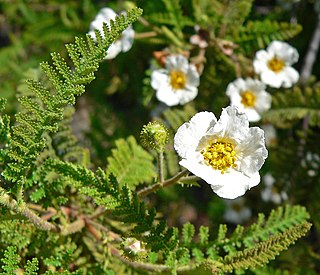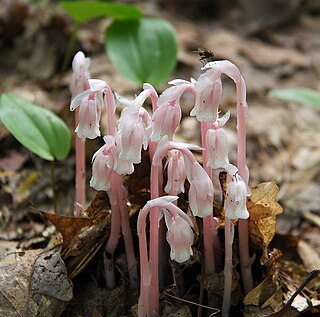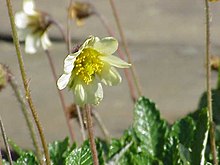
Rosaceae, the rose family, is a medium-sized family of flowering plants that includes 4,828 known species in 91 genera.

Rubiaceae is a family of flowering plants, commonly known as the coffee, madder, or bedstraw family. It consists of terrestrial trees, shrubs, lianas, or herbs that are recognizable by simple, opposite leaves with interpetiolar stipules and sympetalous actinomorphic flowers. The family contains about 13,500 species in about 620 genera, which makes it the fourth-largest angiosperm family. Rubiaceae has a cosmopolitan distribution; however, the largest species diversity is concentrated in the tropics and subtropics. Economically important genera include Coffea, the source of coffee, Cinchona, the source of the antimalarial alkaloid quinine, ornamental cultivars, and historically some dye plants.

The MaloideaeC.Weber was the apple subfamily, a grouping used by some taxonomists within the rose family, Rosaceae. Recent molecular phylogenetic evidence has shown that the traditional Spiraeoideae and Amygdaloideae form part of the same clade as the traditional Maloideae, and the correct name for this group is Amygdaloideae. Earlier circumscriptions of Maloideae are more-or-less equivalent to subtribe Malinae or to tribe Maleae. The group includes a number of plants bearing commercially important fruits, such as apples and pears, while others are cultivated as ornamentals.

Amygdaloideae is a subfamily within the flowering plant family Rosaceae. It was formerly considered by some authors to be separate from Rosaceae, and the family names Prunaceae and Amygdalaceae have been used. Reanalysis from 2007 has shown that the previous definition of subfamily Spiraeoideae was paraphyletic. To solve this problem, a larger subfamily was defined that includes the former Amygdaloideae, Spiraeoideae, and Maloideae. This subfamily, however, is to be called Amygdaloideae rather than Spiraeoideae under the International Code of Nomenclature for algae, fungi, and plants as updated in 2011.

The subfamily Spiraeoideae was traditionally a subfamily of flowering plants within the family Rosaceae. The taxonomy of this subfamily has changed several times in the last century as more detailed studies have been carried out. Spiraeoideae as defined before 2007 is paraphyletic, leading some authors to define a broader subfamily which includes the Spiraeoideae as well as the Maleae, and the Amygdaloideae. Such an expanded subfamily is to be called Amygdaloideae under the International Code of Nomenclature for algae, fungi, and plants.

The Fabaceae or Leguminosae, commonly known as the legume, pea, or bean family, are a large and agriculturally important family of flowering plants. It includes trees, shrubs, and perennial or annual herbaceous plants, which are easily recognized by their fruit (legume) and their compound, stipulate leaves. The family is widely distributed, and is the third-largest land plant family in number of species, behind only the Orchidaceae and Asteraceae, with about 765 genera and nearly 20,000 known species.

Ranunculaceae is a family of over 2,000 known species of flowering plants in 43 genera, distributed worldwide.

The Casuarinaceae are a family of dicotyledonous flowering plants placed in the order Fagales, consisting of four genera and 91 species of trees and shrubs native to eastern Africa, Australia, Southeast Asia, Malesia, Papuasia, and the Pacific Islands. At one time, all species were placed in the genus Casuarina. Lawrence Alexander Sidney Johnson separated out many of those species and renamed them into the new genera of Gymnostoma in 1980 and 1982, Allocasuarina in 1982, and Ceuthostoma in 1988, with some additional formal descriptions of new species in each other genus. At the time, it was somewhat controversial. The monophyly of these genera was later supported in a 2003 phylogenetic study of the family. In the Wettstein system, this family was the only one placed in the order Verticillatae. Likewise, in the Engler, Cronquist, and Kubitzki systems, the Casuarinaceae were the only family placed in the order Casuarinales.

Dryas is a genus of perennial cushion-forming evergreen dwarf shrubs in the family Rosaceae, native to the arctic and alpine regions of Europe, Asia and North America. The genus is named after the dryads, the tree nymphs of ancient Greek mythology. The classification of Dryas within the Rosaceae has been unclear. The genus was formerly placed in the subfamily Rosoideae, but is now placed in subfamily Dryadoideae.

Cercocarpus, commonly known as mountain mahogany, is a small genus of at least nine species of nitrogen-fixing flowering plants in the rose family, Rosaceae. They are native to the western United States and northern Mexico, where they grow in chaparral and semidesert habitats and climates, often at high altitudes. Several are found in the California chaparral and woodlands ecoregion.

Root nodules are found on the roots of plants, primarily legumes, that form a symbiosis with nitrogen-fixing bacteria. Under nitrogen-limiting conditions, capable plants form a symbiotic relationship with a host-specific strain of bacteria known as rhizobia. This process has evolved multiple times within the legumes, as well as in other species found within the Rosid clade. Legume crops include beans, peas, and soybeans.

Frankia is a genus of nitrogen-fixing bacteria that live in symbiosis with actinorhizal plants, similar to the Rhizobium bacteria found in the root nodules of legumes in the family Fabaceae. Frankia also initiate the forming of root nodules.

Purshia is a small genus of 5–8 species of flowering plants in the family Rosaceae which are native to western North America.

Chamaebatia, also known as mountain misery, is a genus of two species of aromatic evergreen shrubs endemic to California. Its English common name derives from early settlers' experience with the plant's dense tangle and sticky, strong-smelling resin. They are actinorhizal, non-legumes capable of nitrogen fixation through symbiosis with the actinobacterium, Frankia.
Actinorhizal plants are a group of angiosperms characterized by their ability to form a symbiosis with the nitrogen fixing actinomycetota Frankia. This association leads to the formation of nitrogen-fixing root nodules.

Neillieae is a tribe of flowering plants in rose family and the Amygdaloideae subfamily. It includes the genera Physocarpus and Neillia.

The Maleae are the apple tribe in the rose family, Rosaceae. The group includes a number of plants bearing commercially important fruits, such as apples and pears, while others are cultivated as ornamentals. Older taxonomies separated some of this group as tribe Crataegeae, as the Cydonia group, or some genera were placed in family Quillajaceae.

Monotropoideae, sometimes referred to as monotropes, are a flowering plant subfamily in the family Ericaceae. Members of this subfamily are notable for their mycoheterotrophic and non-photosynthesizing or achlorophyllous characteristics.
Martin Parniske is a German biologist with a specialisation in genetics, microbiology and biochemistry. He is university professor and head of the Institute of Genetics at the Faculty of Biology of the Ludwig Maximilian University of Munich. Parniske's scientific focus is on the molecular interaction between plants and symbiotic and pathogenic organisms including bacteria, fungi, oomycetes and insects.

A symbiosome is a specialised compartment in a host cell that houses an endosymbiont in a symbiotic relationship.


















